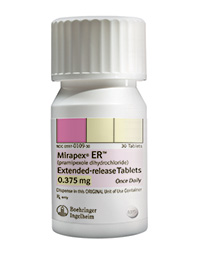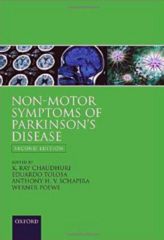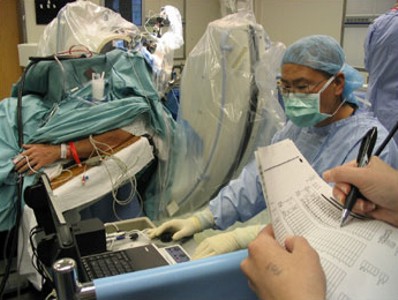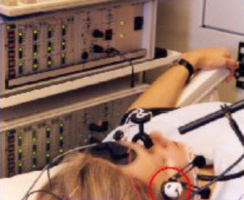.gif) VIARTIS
|
||||||||||||
|
PARKINSON'S DISEASE |
||||||||||||
|
|
||||||||||||
|
|
PARKINSON'S DISEASE NEWS
|
|
||||||||||
|
DECEMBER 2014
28th December 2014 - New research EFFECT OF PRAMIPEXOLE ER FOR PARKINSON'S DISEASE
The long term use of pramipexole as a once-daily extended-release oral formulation in early or advanced Parkinson's Disease demonstrated efficacy, but also adverse events. Pramipexole is a dopamine agonist that is most widely sold as Mirapex ER. For more information go to : Mirapex ER
These results support the long-term efficacy of pramipexole ER in early and advanced Parkinson's Disease. Adverse Events were typical for dopaminergic medications. UPDRS (Parkinson's Disease) scores suggested sustained symptomatic benefit. Reference : European Journal of Neurology [2014] 21 (5) : 736-743 (R.A.Hauser, A.H. Schapira, P.Barone, Y.Mizuno, O.Rascol, M.Busse, C.Debieuvre, M.Fraessdorf, W.Poewe) Complete abstract In order to refer to this article on its own click here
27th December 2014 - New book NON-MOTOR SYMPTOMS OF PARKINSON'S DISEASE K.Ray Chaudhuri, Eduardo Tolosa, Anthony H.V.Schapira, Werner Poewe
22nd December 2014 - New research LONG TERM EFFECTS OF DBS ON PARKINSON'S DISEASE
Deep Brain Stimulation of the Subthalamic Nucleus (STN-DBS) is an effective treatment for Parkinson's Disease, but in the long term Parkinson's Disease symptoms have been found to still deteriorate very significantly. DBS involves the use of electrodes that are implanted into the brain and connected to a small electrical device called a pulse generator that can be externally programmed. For more information go to : Deep Brain Stimulation
The study confirmed the long-term safety of STN-DBS in Parkinson's Disease. However, the functionality of patients worsens over time, mainly for the onset and progression of L-dopa-resistant and non-motor symptoms. The role of PD-subtype seems to be relevant in the long-term outcome. Reference : Parkinsonism Related Disorders [2014] 20 (4) : 376-381 (M.G.Rizzone, A. Fasano, A.Daniele, M.Zibetti, A.Merola, L.Rizzi, C.Piano, C.Piccininni, L.M.Romito, L. Lopiano, A.Albanese) Complete abstract In order to refer to this article on its own click here
12th December 2014 - New research AMPHETAMINES INCREASE THE RISK OF PARKINSON'S DISEASE
Previous neurotoxicity findings raised concerns that Amphetamines and Methamphetamines might damage dopaminergic neurons, resulting in dopamine-related medical disorders such as Parkinson's Disease. However, despite widespread use of methamphetamines and other amphetamine type stimulants little was known about the long-term medical consequences of their abuse and dependence.
The greatly increased likelihood of developing Parkinson's Disease probably occurs because of the long term effect of amphetamines on the dopamine receptors, which they affect. Reference : Drug and Alcohol Dependence [2014] Nov 16 [Epub ahead of print] (K.Curtin, A.E.Fleckenstein, R.J.Robison, M.J.Crookston, K.R.Smith, G.R.Hanson) Complete abstract In order to refer to this article on its own click here
7th December 2014 - New research SIGNS OF PARKINSON'S DISEASE BEFORE DIAGNOSIS
By the time somebody has been diagnosed with Parkinson's Disease many people have already had Parkinson's Disease for years or have had symptoms that were progressing towards it. Researchers compared those symptoms before diagnosis to their subsequent diagnosis. Those symptoms assessed were : motor features (tremor, rigidity, balance impairments, neck pain or stiffness, and shoulder pain or stiffness), autonomic features (constipation, hypotension, erectile dysfunction, urinary dysfunction, and dizziness), neuropsychiatric disturbances (memory problems, late-onset anxiety or depression, cognitive decline, and apathy), and fatigue, insomnia, anosmia, hypersalivation and REM sleep disorder) prior to diagnosis.
A range of symptoms can therefore be detected years before diagnosis of Parkinson's Disease, with tremor being especially common prior to diagnosis. Reference : Lancet Neurology [2014] Nov 26 [Epub ahead of print] (A.Schrag, L.Horsfall, K.Walters, A.Noyce, I.Petersen) Complete abstract In order to refer to this article on its own click here
2nd December 2014 - New research SONOGRAPHY FOR DIAGNOSIS OF PARKINSON'S DISEASE
Transcranial sonography is a non-invasive diagnostic technique that makes use of sound waves to create a digital image to aid the diagnosis of Parkinson's Disease.
The primary area of the brain concerning Parkinson's Disease is the substantia nigra. The substantia nigra echogenic area was found to be larger in those people with Parkinson's Disease. Substantia nigra echogenicity was also larger in males than in females. Age did not correlate with substantia nigra echogenicity in any group. After multivariate analysis, only the substantia nigra hyperechogenicity was associated with the diagnosis of Parkinson's Disease. Transcranial sonography consequently showed good diagnostic validity for the diagnosis of Parkinson's Disease. However, in a previous study the diagnostic accuracy in the early stages of Parkinson's Disease was not sufficient for routine clinical use. Reference : Journal of Ultrasound in Medicine [2014] 33 (12) : 2069-2074 (A.Alonso- Cánovas, J.L.López-Sendón, J.Buisán, A.deFelipe-Mimbrera, M.Guillán, N.García-Barragán, I.Corral, M.C.Matute-Lozano, J.Masjuan, J.C.Martínez-Castrillo, U.Walter) Complete abstract In order to refer to this article on its own click here
|
||||||||||||
.gif) |
||||||||||||
| ©2006-2014 Viartis | ||||||||||||
| [email protected] | ||||||||||||

 Publisher's
description : Patients with Parkinson's disease (PD) are known to suffer from
motor symptoms, but also experience non-motor symptoms (NMS) that are often
present before diagnosis or that inevitably emerge with disease progression. The
motor symptoms of Parkinson's disease have been extensively researched, and
effective clinical tools for their assessment and treatment are readily
available. Researchers have recently begun to focus on the NMS of Parkinson's
Disease, which are poorly recognized and inadequately treated. NMS have an
impact on patient quality of life and mortality and include neuropsychiatric,
sleep-related, autonomic, gastrointestinal, and sensory symptoms. Some NMS can
be improved with available treatments, but others will require research into
novel therapies. This new edition summarizes the current understanding of NMS in
Parkinson's disease and future research.
Publisher's
description : Patients with Parkinson's disease (PD) are known to suffer from
motor symptoms, but also experience non-motor symptoms (NMS) that are often
present before diagnosis or that inevitably emerge with disease progression. The
motor symptoms of Parkinson's disease have been extensively researched, and
effective clinical tools for their assessment and treatment are readily
available. Researchers have recently begun to focus on the NMS of Parkinson's
Disease, which are poorly recognized and inadequately treated. NMS have an
impact on patient quality of life and mortality and include neuropsychiatric,
sleep-related, autonomic, gastrointestinal, and sensory symptoms. Some NMS can
be improved with available treatments, but others will require research into
novel therapies. This new edition summarizes the current understanding of NMS in
Parkinson's disease and future research.

 A
retrospective design was used to examine medical records from 1996 until
2011. Patients were divided between (1) Amphetamine and Methamphetamine
users, (2) Cocaine users, (3) those people that have not been exposed to
drugs or alcohol. They were assessed to see if they were at an increased
risk of developing either (1) Parkinson's Disease, or (2) Parkinson's
Disease / Parkinsonism / Essential Tremor when compared to people that did
not take drugs.
A
retrospective design was used to examine medical records from 1996 until
2011. Patients were divided between (1) Amphetamine and Methamphetamine
users, (2) Cocaine users, (3) those people that have not been exposed to
drugs or alcohol. They were assessed to see if they were at an increased
risk of developing either (1) Parkinson's Disease, or (2) Parkinson's
Disease / Parkinsonism / Essential Tremor when compared to people that did
not take drugs.  At 10 years before diagnosis the incidence of tremor was many
times higher and constipation was higher in those who went on to develop
Parkinson's Disease. At 5 years before diagnosis those who went on to
develop Parkinson's Disease had a much higher incidence of tremor, a higher
incidence of imbalance, constipation, hypotension, and a slightly higher
incidence of erectile dysfunction, urinary dysfunction, dizziness, fatigue,
depression, and anxiety. At 2 years before diagnosis the incidence of all
studied features except neck pain or stiffness was higher in people who went
on to develop Parkinson's Disease.
At 10 years before diagnosis the incidence of tremor was many
times higher and constipation was higher in those who went on to develop
Parkinson's Disease. At 5 years before diagnosis those who went on to
develop Parkinson's Disease had a much higher incidence of tremor, a higher
incidence of imbalance, constipation, hypotension, and a slightly higher
incidence of erectile dysfunction, urinary dysfunction, dizziness, fatigue,
depression, and anxiety. At 2 years before diagnosis the incidence of all
studied features except neck pain or stiffness was higher in people who went
on to develop Parkinson's Disease. The
sound waves are typically produced by a transducer. Strong, short electrical
pulses from the ultrasound machine make the transducer ring at the desired
frequency. Materials on the face of the transducer enable the sound to be
transmitted efficiently into the body. The sound wave is partially reflected
from layers between different tissues. Sound is reflected anywhere there are
density changes in the body. Some of the reflections return to the
transducer. The return sound wave vibrates the transducer, which turns the
vibrations into electrical pulses that travel to the ultrasonic scanner
where they are processed and transformed into a digital image. For more
information go to
The
sound waves are typically produced by a transducer. Strong, short electrical
pulses from the ultrasound machine make the transducer ring at the desired
frequency. Materials on the face of the transducer enable the sound to be
transmitted efficiently into the body. The sound wave is partially reflected
from layers between different tissues. Sound is reflected anywhere there are
density changes in the body. Some of the reflections return to the
transducer. The return sound wave vibrates the transducer, which turns the
vibrations into electrical pulses that travel to the ultrasonic scanner
where they are processed and transformed into a digital image. For more
information go to